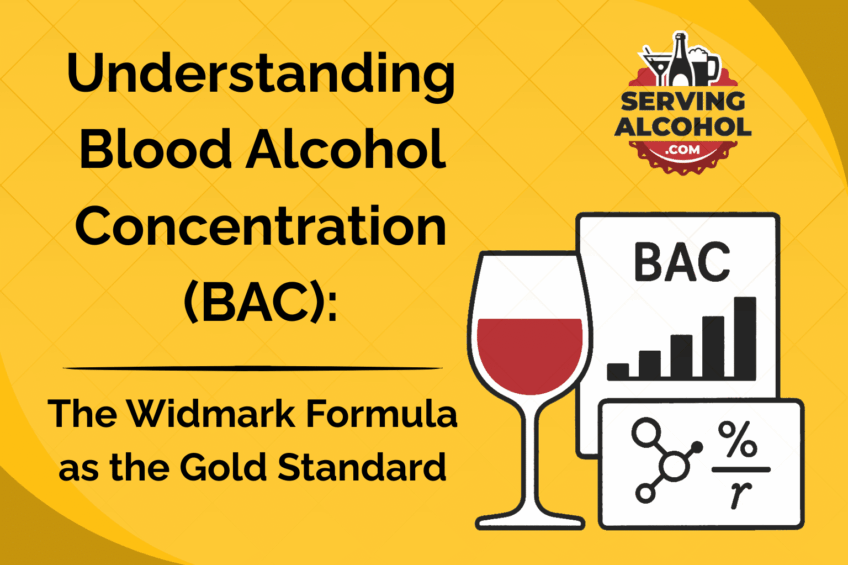In the hospitality industry, knowledge of blood alcohol concentration (BAC) is essential for ensuring guest safety, legal (driving and serving possibly visibly intoxicated individuals, for example) compliance, and responsible alcohol service. Among the various methods for estimating blood alcohol concentration (BAC), researchers widely recognize the Widmark Formula as the gold standard due to its scientific accuracy and its foundational role in alcohol-related research and policy.
What is Blood Alcohol Concentration? (BAC)
BAC refers to the amount of alcohol present in a person’s bloodstream, expressed as a percentage. For example, a BAC of 0.08% means that 0.08% of a person’s blood by volume is alcohol. BAC is a critical measurement because it directly correlates with the physiological and behavioral effects of alcohol, as well as legal limits for activities such as driving. The current national average for driving while under the Influence is double the legal limit for driving of 0.08% BAC. That’s 0.16%!
Why BAC Matters to Hospitality Managers
Guest Safety
BAC levels significantly impact a guest’s physical coordination and cognitive functions. As BAC levels rise, so does the risk of potential hazards, including accidents, confrontations, and medical emergencies. Hospitality staff must understand the implications of BAC, as this knowledge enables them to recognize when a guest may be in danger due to impairment. By monitoring BAC levels and being aware of their effects, staff can intervene appropriately to ensure the safety of guests, promote responsible drinking, and maintain a secure environment. This proactive approach not only protects individual guests but also contributes to the overall safety and well-being of the establishment.
Legal Compliance
Hospitality establishments, such as bars, restaurants, and nightclubs, play a vital role in fostering social interactions and providing enjoyable experiences for their patrons. However, with this responsibility comes the obligation to adhere to legal standards that ensure customers’ and staff’s safety and well-being. Customers should not be leaving your establishment after reaching a 0.08% BAC. One crucial aspect of this compliance is prohibiting serving possibly visibly intoxicated individuals.
The law requires establishments to refrain from serving alcohol to patrons who exhibit signs of excessive impairment, not only to protect the individuals themselves but also to minimize the risk of accidents, altercations, or other harmful incidents resulting from overconsumption. By adhering to these regulations, businesses contribute to a safer environment and safeguard themselves from potential liability under dram shop laws. These laws hold establishments legally accountable for the actions of their intoxicated patrons, particularly if those individuals cause harm to themselves or others after being served alcohol.
Monitoring BAC levels, even indirectly, is a proactive approach to ensuring compliance with these laws. Staff can be trained to recognize the behavioral and physical indicators of impairment, allowing them to make informed decisions about when to stop serving alcohol. Policies promoting responsible service, such as offering drink limits or non-alcoholic alternatives, can further enhance this monitoring process.
In addition to legal compliance, prioritizing the monitoring of BAC levels fosters a culture of responsibility within the establishment. This approach can minimize the risks associated with alcohol service, ultimately protecting the business’s reputation. Establishments known for their responsible alcohol service can attract a more diverse clientele and encourage safer drinking practices among customers.
In summary, hospitality establishments must understand and implement measures to comply with laws regarding service to visibly intoxicated individuals. By actively monitoring BAC levels and educating staff on responsible service practices, businesses can protect themselves legally while promoting a safer, more enjoyable environment for all patrons.
Responsible Alcohol Service
Staff who understand how BAC changes based on factors like drinking speed and body weight, for example, can make more informed decisions about when to slow down or stop serving alcohol to a guest.
Drinking Speed
Drinking speed significantly affects how quickly alcohol enters the bloodstream. When guests consume drinks rapidly, their BAC can spike in a short time, increasing the risk of impairment. In contrast, pacing drinks over a more extended period allows the body more time to metabolize alcohol, reducing the likelihood of reaching dangerous impairment levels.
Body Weight
Body weight also plays a significant role. It determines how alcohol is distributed throughout the body. Typically, individuals with higher body weight reach a lower BAC than lighter individuals when consuming the same amount of alcohol. This understanding helps staff assess impairment more accurately based on a guest’s size and drinking habits.
For more information on factors that can affect BAC, such as drugs (illegal or legal), meals, and other factors, please check out our responsible alcohol seller-server course offered across many states.
The Widmark Formula: The Gold Standard for BAC Calculation
Developed by Swedish scientist Erik M.P. Widmark in the early 20th century, the Widmark Formula provides a reliable method for estimating BAC. Its enduring relevance and application in legal, medical, and hospitality contexts make it the benchmark against which other methods are measured.
The formula:

Where:
- A: Total alcohol consumed in grams.
- r: Alcohol distribution ratio (approximately 0.68 for men and 0.55 for women due to differences in body composition).
- W: Body weight in kilograms.
- β: Elimination rate of alcohol from the bloodstream, typically ~0.015% per hour.
- T: Time elapsed since the first drink.
This formula accounts for body weight, gender, and time, accurately estimating BAC levels.
Practical Applications of the Widmark Formula in Hospitality
Training Staff
Incorporate the principles of the Widmark Formula into employee training programs to help staff estimate how alcohol affects guests based on observable factors like drink size and time intervals. To effectively educate staff on responsible alcohol service and the potential impact of alcohol on guests, incorporate a comprehensive training program that utilizes the principles of the Widmark Formula.
This training should go beyond essential awareness and equip staff with the knowledge to:
-
Estimate Blood Alcohol Concentration (BAC)
-
-
- The course you use should show how to use observable factors such as the type and number of drinks consumed, the time elapsed between drinks, and the guest’s weight and gender to approximate a guest’s BAC. This understanding will enable them to recognize signs of impairment and intervene appropriately. To effectively assess a guest’s level of impairment and potential alcohol-related risks, staff should actively observe key factors and apply tools like the Widmark Formula to estimate Blood Alcohol Concentration (BAC). The effectiveness of determining someone’s blood alcohol level involves understanding how the type and number of drinks consumed contribute to BAC, considering the alcohol content and serving size of each beverage.
- Course material should also include practical exercises and scenarios that allow staff to apply these concepts in real-world situations.
- Understand Individual Variations
- The course material should cover the individual factors, such as metabolism, food consumption, and medication use, that can significantly affect BAC.
-
-
Identify Risk Factors
-
- The course should train staff to identify guests who may be at higher risk of impairment, such as those who are drinking on an empty stomach, consuming alcohol rapidly, or mixing alcohol with medications.
Serving Alcohol’s responsible alcohol seller-server courses cover these three vital topics in our first section of the course, Alcohol Awareness.
Why the Widmark Formula is the Gold Standard
- Scientific Accuracy:
- Decades of research into how the body distributes and metabolizes alcohol led to the development of the Widmark Formula. Its accuracy makes it a cornerstone in setting legal BAC limits and conducting forensic investigations.
- Universality:
- The formula’s variables, such as the alcohol distribution ratio and elimination rate, apply universally, making it adaptable across various contexts and populations.
- Predictive Power:
- By incorporating key factors like body weight and elapsed time, the Widmark Formula provides a realistic estimate of BAC, which is critical for understanding how alcohol affects an individual’s behavior and capabilities.
- Legal and Policy Relevance:
- Many laws and regulations regarding alcohol consumption and impairment rely on the principles of the Widmark Formula to define safe limits and determine liability.
The Role of BAC (Blood Alcohol Content) for Managers

As discussed, BAC is essential to maintaining a safe, legal, and responsible drinking environment. Whether you’re serving alcohol at a bar, restaurant, event, or retail setting, knowing how BAC works allows you to make informed decisions that protect your patrons, your license, and your establishment.
BAC measures the amount of alcohol in a person’s bloodstream and reflects several key influencing factors, including body weight, sex, rate of consumption, and food intake. Each of these elements plays a role in how the body absorbs and processes alcohol.
Even slight increases in BAC can impair coordination, judgment, and reaction time. These changes make BAC an essential indicator when assessing whether a guest may be approaching impairment. By understanding how BAC works, staff can recognize early signs of impairment and take appropriate steps to maintain a safe and responsible drinking environment.
At Serving Alcohol, we stress the importance of proactive alcohol service in our responsible alcohol seller-server courses using the Widmark Formula. Want to learn more about Serving Alcohol? Download our info sheet! Monitoring your guests’ BAC—whether directly or through behavioral indicators—helps prevent overservice, avoid legal consequences, and reduce the risk of alcohol-related incidents.
Trained alcohol servers should understand legal BAC limits, recognize signs that someone may be approaching or exceeding those limits, and apply intervention techniques when necessary. Responsible service isn’t just a best practice—it’s your front line of defense against liability.
By incorporating BAC awareness into your daily operations, you demonstrate professionalism, prioritize safety, and help create an environment where everyone, from staff to guests, can enjoy themselves responsibly.














